‘Urban-Rural’ Gradient Analysis of Landscape Changes around Cities in Mountainous Regions: A Case Study of the Hengduan Mountain Region in Southwest China
Abstract
:1. Introduction
2. Materials and Methods
2.1. Study Area
2.2. Remote Sensing Images and Data Processing
2.3. Framework
2.3.1. The ‘Urban-Rural’ Gradient
2.3.2. Landscape Metrics
2.3.3. Urban Sprawl and Relationship with Terrain
3. Results
3.1. Land Use Changes around Cities
3.2. Urban Sprawl and Terrain
3.3. Spatial Heterogeneity of Landscape Patterns around Cities
3.4. Temporal Changes of Landscape Patterns around Cities
4. Discussion
4.1. Scale and Sprawl of Mountain Cities
4.2. Landscape Changes along the ‘Urban-Rural’ Gradient
4.3. Landscape Changes Responses to the Urban Sprawl
4.4. Limitations and Caveats
5. Conclusions
Acknowledgments
Author Contributions
Conflicts of Interest
References
- Seto, K.C.; Fragkias, M. Quantifying spatiotemporal patterns of urban land-use change in four cities of China with time series landscape metrics. Landsc. Ecol. 2005, 20, 871–888. [Google Scholar] [CrossRef]
- Wu, W.; Zhao, S.; Zhu, C.; Jiang, J. A comparative study of urban expansion in Beijing, Tianjin and Shijiazhuang over the past three decades. Landsc. Urban Plan. 2015, 134, 93–106. [Google Scholar] [CrossRef]
- Anwar, B.; Xiao, Z.; Akter, S.; Rehman, R. Sustainable Urbanization and Development Goals Strategy through Public–Private Partnerships in a South-Asian Metropolis. Sustainability 2017, 9, 1940. [Google Scholar] [CrossRef]
- United Nations, Department of Economic and Social Affairs, Popolation Division. World Urbanization Prospects: The 2014 Revision, Highlights (ST/ESA/SER.A/352). 2014. Available online: http://www.urbangateway.org/system/files/documents/urbangateway/wup2014-highlights.pdf (accessed on 17 July 2017 ).
- National Bureau of Statistics of China. China Population and Employment Statistics Yearbook 2011; China Statistics Press: Beijing, China, 2012.
- Salman, S.M.A. Inter-states water disputes in India: An analysis of the settlement process. Water Policy 2002, 4, 223–237. [Google Scholar] [CrossRef]
- Al-Kharabsheh, A.; Ta’Any, R. Influence of urbanization on water quality deterioration during drought periods at South Jordan. J. Arid Environ. 2003, 53, 619–630. [Google Scholar] [CrossRef]
- Kim, D.S.; Mizuno, K.; Kobayashi, S. Analysis of urbanization characteristics causing farmland loss in a rapid growth area using GIS and RS. Paddy Water Environ. 2003, 1, 189–199. [Google Scholar] [CrossRef]
- Burak, S.; Dogˇan, E.; Gaziogˇlu, C. Impact of urbanization and tourism on coastal environment. Ocean Coast. Manag. 2004, 47, 515–527. [Google Scholar] [CrossRef]
- Güneralp, B.; Seto, K.C. Environmental impacts of urban growth from an integrated dynamic perspective: A case study of Shenzhen, South China. Global Environ. Change 2008, 18, 720–735. [Google Scholar] [CrossRef]
- Eigenbrod, F.; Bell, V.A.; Davies, H.N.; Heinemeyer, A.; Armsworth, P.R.; Gaston, K.J. The impact of projected increases in urbanization on ecosystem services. Proc. R. Soc. Lond. B Boil. Sci. 2011, 278, 3201–3208. [Google Scholar] [CrossRef] [PubMed]
- Seto, K.C.; Güneralp, B.; Hutyra, L.R. Global forecasts of urban expansion to 2030 and direct impacts on biodiversity and carbon pools. Proc. Natl. Acad. Sci. USA 2012, 109, 16083–16088. [Google Scholar] [CrossRef] [PubMed]
- Han, L.; Zhou, W.; Li, W. Increasing impact of urban fine particles (PM2.5) on areas surrounding Chinese cities. Sci. Rep. 2015, 5. [Google Scholar] [CrossRef] [PubMed]
- Huang, J.; Zhang, W.; Mo, J.M.; Wang, S.Z.; Liu, J.X.; Chen, H. Urbanization in China drives soil acidification of Pinus massoniana forests. Sci. Rep. 2015, 5. [Google Scholar] [CrossRef] [PubMed]
- Peng, J.; Shen, H.; Wu, W.H.; Liu, Y.X.; Wang, Y.L. Net primary productivity (NPP) dynamics and associated urbanization driving forces in metropolitan areas: A case study in Beijing City, China. Landsc. Ecol. 2016, 31, 1077–1092. [Google Scholar] [CrossRef]
- Tang, Z.; Sun, G.; Zhang, N.; He, J.; Wu, N. Impacts of Land-Use and Climate Change on Ecosystem Service in Eastern Tibetan Plateau, China. Sustainability 2018, 10, 467. [Google Scholar] [CrossRef]
- Mcdonald, R.I.; Kareiva, P.; Forman, R.T.T. The implications of current and future urbanization for global protected areas and biodiversity conservation. Biol. Conserv. 2008, 141, 1695–1703. [Google Scholar] [CrossRef]
- Mckinney, M.L. Effects of urbanization on species richness: A review of plants and animals. Urban Ecosyst. 2008, 11, 161–176. [Google Scholar] [CrossRef]
- McKinney, M.L. Urbanization as a major cause of biotic homogenization. Biol. Conserv. 2006, 127, 247–260. [Google Scholar] [CrossRef]
- Wratten, S.; Sandhu, H.; Cullen, R.; Costanza, R. Ecosystem Services in Agricultural and Urban Landscapes; Wiley: Hoboken, NJ, USA, 2013. [Google Scholar]
- Imhoff, M.L.; Bounoua, L.; Ricketts, T.; Loucks, C.; Harriss, R.; Lawrence, W.T. Global patterns in human consumption of net primary production. Nature 2004, 429, 870–873. [Google Scholar] [CrossRef] [PubMed]
- Grimm, N.B.; Faeth, S.H.; Golubiewski, N.E.; Redman, C.L.; Wu, J.; Bai, X.; Briggs, J.M. Global Change and the Ecology of Cities. Science 2008, 319, 756–760. [Google Scholar] [CrossRef] [PubMed]
- Cadavid Restrepo, A.M.; Yang, Y.R.; Hamm, N.A.S.; Gray, D.J.; Barnes, T.S.; Williams, G.M.; Soares Magalhães, R.J.; McManus, D.P.; Guo, D.; Clements, A.C.A. Land cover change during a period of extensive landscape restoration in Ningxia Hui Autonomous Region, China. Sci. Total Environ. 2017, 598, 669–679. [Google Scholar] [CrossRef] [PubMed]
- Kleemann, J.; Inkoom, J.N.; Thiel, M.; Shankar, S.; Lautenbach, S.; Fürst, C. Peri-urban land use pattern and its relation to land use planning in Ghana, West Africa. Landsc. Urban Plan. 2017, 165, 280–294. [Google Scholar] [CrossRef]
- Li, Y.; Sulla-Menashe, D.; Motesharrei, S.; Song, X.P.; Kalnay, E.; Ying, Q.; Li, S.C.; Ma, Z. Inconsistent estimates of forest cover change in China between 2000 and 2013 from multiple datasets: Differences in parameters, spatial resolution, and definitions. Sci. Rep. 2017, 7. [Google Scholar] [CrossRef] [PubMed]
- Rodríguez-González, P.M.; Albuquerque, A.; Martínez-Almarza, M.; Díaz-Delgado, R. Long-term monitoring for conservation management: Lessons from a case study integrating remote sensing and field approaches in floodplain forests. J. Environ. Manag. 2017, 202, 392–402. [Google Scholar] [CrossRef] [PubMed]
- Scharsich, V.; Mtata, K.; Hauhs, M.; Lange, H.; Bogner, C. Analysing land cover and land use change in the Matobo National Park and surroundings in Zimbabwe. Remote Sens. Environ. 2017, 194, 278–286. [Google Scholar] [CrossRef]
- Luck, M.; Wu, J. A gradient analysis of urban landscape pattern: A case study from the Phoenix metropolitan region, Arizona, USA. Landsc. Ecol. 2002, 17, 327–339. [Google Scholar] [CrossRef]
- Berling-Wolff, S.; Wu, J. Modeling urban landscape dynamics: A review. Ecol. Res. 2004, 19, 119–129. [Google Scholar] [CrossRef]
- Ahern, J. Urban landscape sustainability and resilience: The promise and challenges of integrating ecology with urban planning and design. Landsc. Ecol. 2013, 28, 1203–1212. [Google Scholar] [CrossRef]
- Lausch, A.; Herzog, F. Applicability of landscape metrics for the monitoring of landscape change: Issues of scale, resolution and interpretability. Ecol. Indic. 2002, 2, 3–15. [Google Scholar] [CrossRef]
- Uuemaa, E.; Mander, Ü.; Marja, R. Trends in the use of landscape spatial metrics as landscape indicators: A review. Ecol. Indic. 2013, 28, 100–106. [Google Scholar] [CrossRef]
- Mõisja, K.; Uuemaa, E.; Oja, T. Integrating small-scale landscape elements into land use/cover: The impact on landscape metrics’ values. Ecol. Indic. 2016, 67, 714–722. [Google Scholar] [CrossRef]
- Fang, S.; Zhao, Y.; Han, L.; Ma, C. Analysis of Landscape Patterns of Arid Valleys in China, Based on Grain Size Effect. Sustainability 2017, 9, 2263. [Google Scholar] [CrossRef]
- Mcdonnell, M.J.; Pickett, S.T.A. Ecosystem Structure and Function along Urban-Rural Gradients: An Unexploited Opportunity for Ecology. Ecology 1990, 71, 1232–1237. [Google Scholar] [CrossRef]
- López, E.; Bocco, G.; Mendoza, M.; Duhau, E. Predicting land-cover and land-use change in the urban fringe: A case in Morelia city, Mexico. Landsc. Urban Plan. 2001, 55, 271–285. [Google Scholar] [CrossRef]
- McDonnell, M.J.; Hahs, A.K. The use of gradient analysis studies in advancing our understanding of the ecology of urbanizing landscapes: Current status and future directions. Landsc. Ecol. 2008, 23, 1143–1155. [Google Scholar] [CrossRef]
- Haase, D.; Nuissl, H. The urban-to-rural gradient of land use change and impervious cover: A long-term trajectory for the city of Leipzig. J. Land Use Sci. 2010, 5, 123–141. [Google Scholar] [CrossRef]
- Qureshi, S.; Haase, D.; Coles, R. The Theorized Urban Gradient (TUG) method—A conceptual framework for socio-ecological sampling in complex urban agglomerations. Ecol. Indic. 2014, 36, 100–110. [Google Scholar] [CrossRef]
- Zhang, Z.; Tu, Y.; Li, X. Quantifying the Spatiotemporal Patterns of Urbanization along Urban-Rural Gradient with a Roadscape Transect Approach: A Case Study in Shanghai, China. Sustainability 2016, 8, 862. [Google Scholar] [CrossRef]
- Li, J.; Li, C.; Zhu, F.; Song, C.; Wu, J. Spatiotemporal pattern of urbanization in Shanghai, China between 1989 and 2005. Landsc. Ecol. 2013, 28, 1545–1565. [Google Scholar] [CrossRef]
- Fan, F.; Fan, W. Understanding spatial-temporal urban expansion pattern (1990–2009) using impervious surface data and landscape indexes: A case study in Guangzhou (China). J. Appl. Remote Sens. 2014, 8, 083609. [Google Scholar] [CrossRef]
- Peng, L.; Chen, T.; Liu, S. Spatiotemporal Dynamics and Drivers of Farmland Changes in Panxi Mountainous Region, China. Sustainability 2016, 8, 1209. [Google Scholar] [CrossRef]
- Millennium Ecosystem Assessment (MEA). Ecosystems and Human Well-Being: Synthesis; Island Press: Washington, DC, USA, 2005. [Google Scholar]
- The Economics of Ecosystems and Biodiversity (TEEB). The Economics of Ecosystems and Biodiversity: Ecological and Economic Foundations; Earthscan: London, UK, 2010. [Google Scholar]
- Grêt-Regamey, A.; Brunner, S.H.; Kienast, F. Mountain Ecosystem Services: Who Cares? Mt. Res. Dev. 2012, 32, S23–S34. [Google Scholar] [CrossRef]
- Zhong, H.X. Study of protection and construction of mountain ecological security barrier in China. J. Mt. Sci. 2008, 26, 2–11. (In Chinese) [Google Scholar]
- Zhang, B.; Mo, S.; Tan, Y.; Xiao, F.; Wu, H. Urbanization and de-urbanization in mountain regions of China. Mt. Res. Dev. 2004, 24, 206–209. [Google Scholar]
- Deng, W.; Tang, W. General directions and countermeasures for urbanization development in mountain areas of China. J. Mt. Sci. 2013, 31, 168–173. [Google Scholar]
- Deng, W.; Xiong, Y.; Zhao, J.; Qiu, D.; Zhang, Z.; Wen, A. Enlightenment from internationa mountain research projects. J. Mt. Sci. 2013, 31, 377–384. [Google Scholar]
- Deng, W.; Fang, Y.; Tang, W. The strategic effect and genera directions of urbanization in mountain areas of China. Bull. Chin. Acad. Sci. 2013, 28, 66–73. (In Chinese) [Google Scholar]
- Deng, W. Discussion on mountain area resource and environment carrying capacity. Geogr. Res. 2010, 29, 959–969. (In Chinese) [Google Scholar]
- Thünen, J.H.V. Der Isolierte Staat in Beziehung auf Landwirtshaft und Nationalökonomie; Fr. Derthes: Hamburg/Rostock, Germany, 1825. [Google Scholar]
- Burgess, E.W. The growth of the city: An introduction to a research project. In The City; Park, R.E., Burgess, E.W., McKenzie, R., Eds.; University of Chicago Press: Chicago, IL, USA, 1925. [Google Scholar]
- Balakrishnan, T.R.; Jarvis, G.K. Is the Burgess concentric zonal theory of spatial differentiation still applicable to urban Canada? Can. Rev. Sociol. 1991, 28, 526–539. [Google Scholar] [CrossRef]
- Meyer, W.B. The other Burgess model. Urban Geogr. 2000, 21, 261–270. [Google Scholar] [CrossRef]
- Pan, T.; Wu, S.; He, D.; Dai, E.; Liu, Y. Ecological effects of Longitudinal Range-Gorge land surface pattern and its regional differentiation. Acta Geogr. Sin. 2012, 67, 13–26. (In Chinese) [Google Scholar]
- The Comprehensive Scientific Expedition to the Qinghai-Xizang Plateau, CAS. Physical Geography of Hengduan Mountains; Science Press: Beijing, China, 1997. [Google Scholar]
- Liu, J.; Zhang, Z.; Xu, X.; Kuang, W.; Zhuo, W.; Zhang, S.; Li, R.; Yan, C.; Yu, D.; Wu, S.; et al. Spatial patterns and driving forces of land use change in China during the early 21st century. J. Geogr. Sci. 2010, 20, 483–494. [Google Scholar] [CrossRef]
- Turner, M.G. Spatial and temporal analysis of landscape patterns. Landsc. Ecol. 1990, 4, 21–30. [Google Scholar] [CrossRef]
- Baker, W.L.; Cai, Y. The r.le programs for multiscale analysis of landscape structure using the GRASS geographical information system. Landsc. Ecol. 1992, 7, 291–302. [Google Scholar] [CrossRef]
- Wu, J. Landscape Ecology: Pattern, Process, Scale and Hierarchy; Higher Education Press: Beijing, China, 2000. (In Chinese) [Google Scholar]
- Feng, Z.; Tang, Y.; Yang, Y.; Zhang, D. Relief degree of land surface and its influence on population distribution in China. J. Geogr. Sci. 2008, 18, 237–246. [Google Scholar] [CrossRef]
- National Bureau of Statistics of China. China Statistical Yearbook; China Statistics Press: Beijing, China, 2012.
- Hu, H.; Wei, H.; Yan, S. Research on the Optimization of Spatial Structure of Urbanization in Western China. Res. Dev. 2015, 5, 1–7. [Google Scholar]
- Wu, J. Effects of changing scale on landscape pattern analysis: Scaling relations. Landsc. Ecol. 2004, 19, 125–138. [Google Scholar] [CrossRef]
- Yu, L.; Fu, Y.; Yu, H.; Li, Z. Landscape pattern gradient dynamics and desakota features in rapid urbanization area: A case study in Panyu of Guangzhou. Chin. J. Appl. Ecol. 2011, 22, 171–180. (In Chinese) [Google Scholar]
- Deng, J.S.; Wang, K.; Hong, Y.; Qi, J.G. Spatio-temporal dynamics and evolution of land use change and landscape pattern in response to rapid urbanization. Landsc. Urban Plan. 2009, 92, 187–198. [Google Scholar] [CrossRef]
- Ma, X.; Jin, Y. Study on Counteractive Mechanism between Urban Land Use Change and Tourism Development. Tour. Trib. 2014, 29, 87–96. (In Chinese) [Google Scholar]
- Larondelle, N.; Haase, D. Urban ecosystem services assessment along a rural–urban gradient: A cross-analysis of European cities. Ecol. Indic. 2013, 29, 179–190. [Google Scholar] [CrossRef]
- Dietzel, C.; Herold, M.; Hemphill, J.J.; Clarke, K.C. Spatio-temporal dynamics in California’s Central Valley: Empirical links to urban theory. Int. J. Geogr. Inf. Sci. 2005, 19, 175–195. [Google Scholar] [CrossRef]
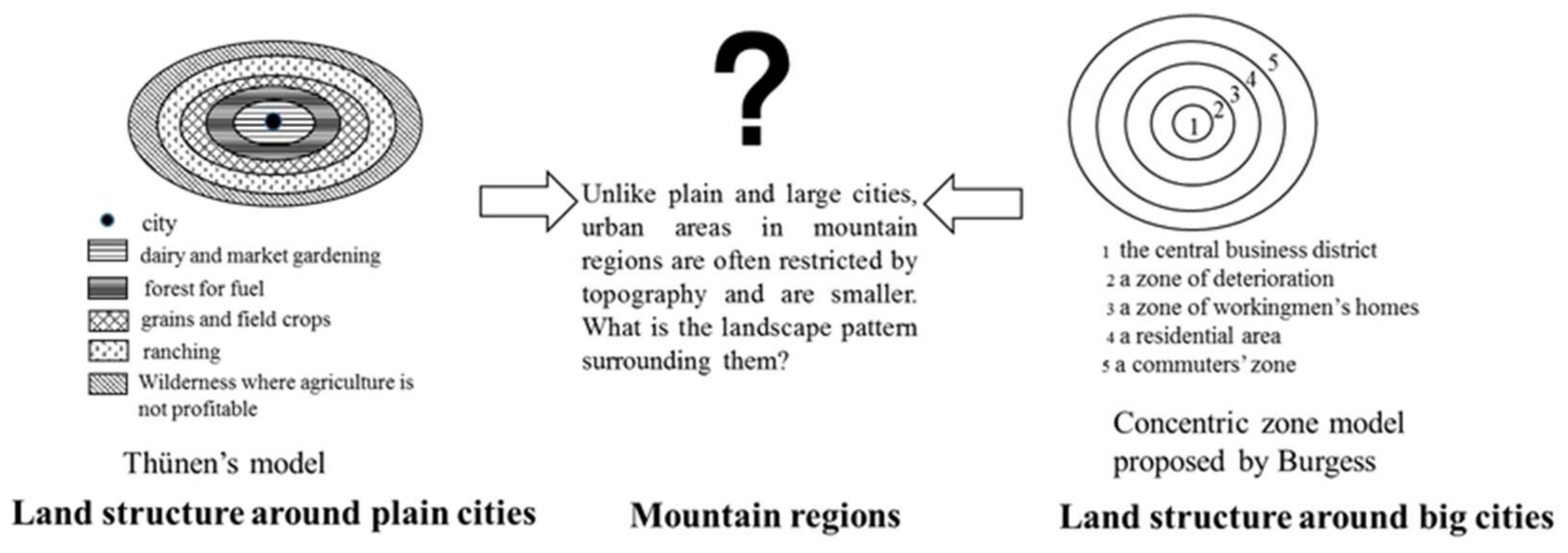





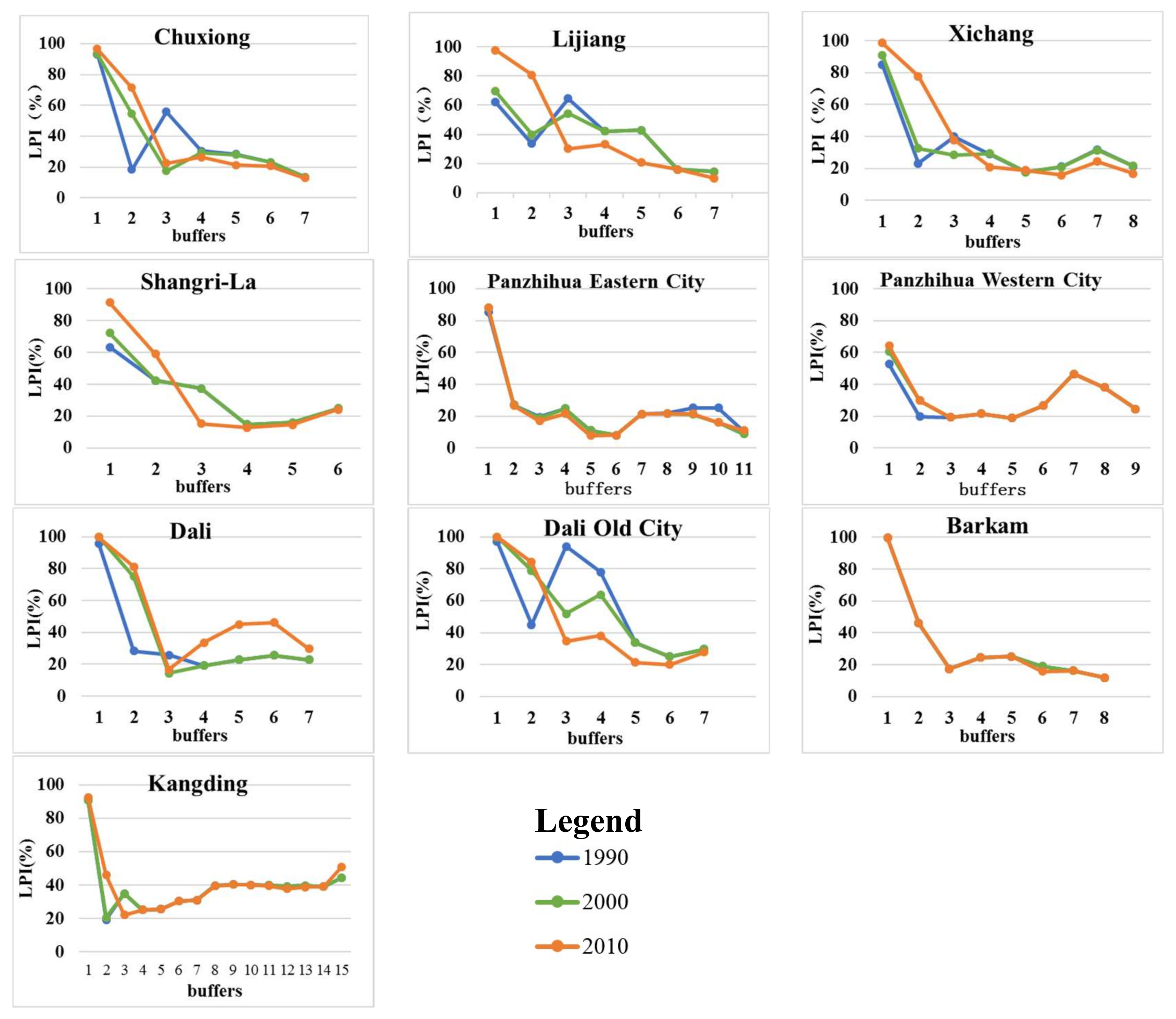
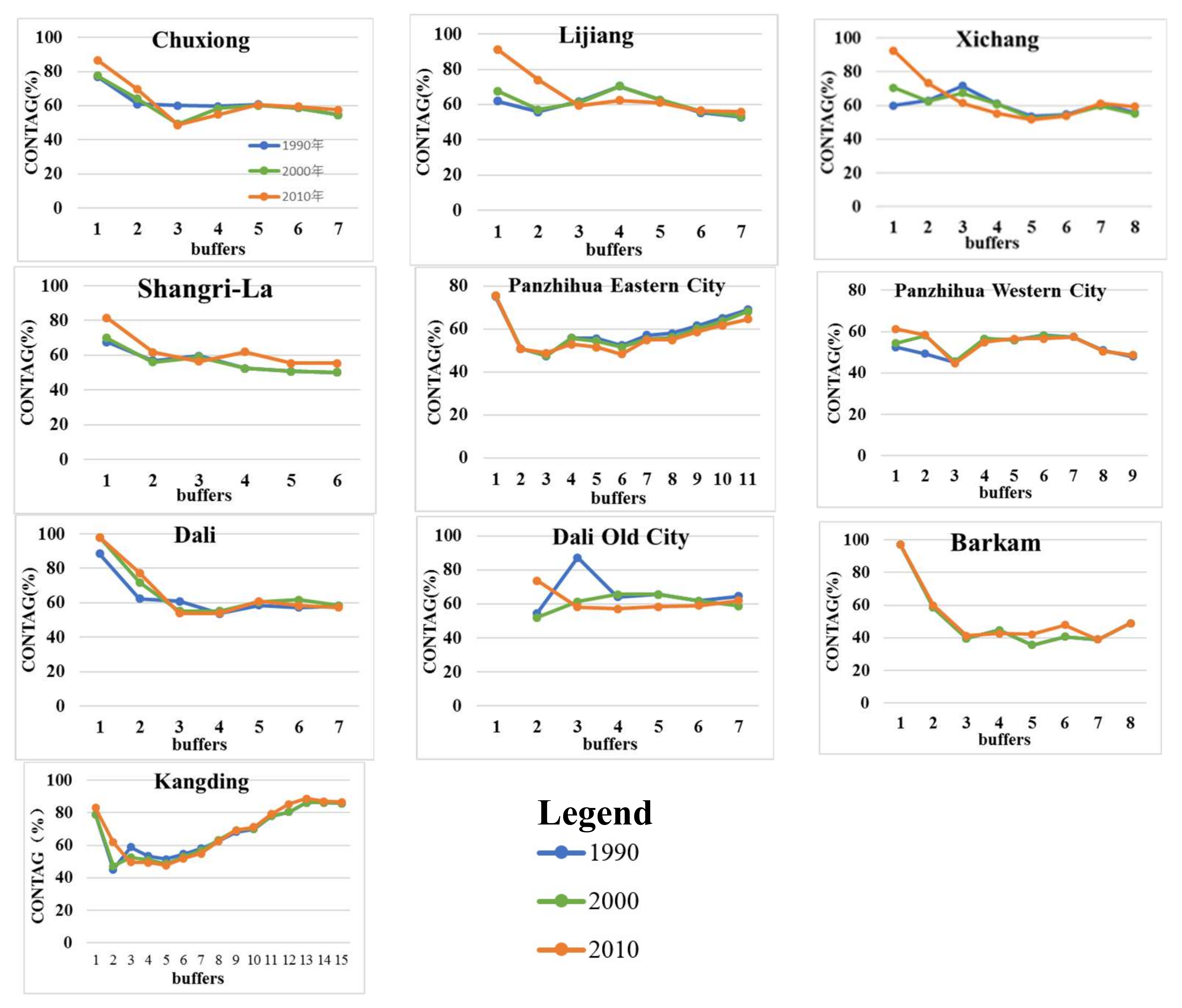

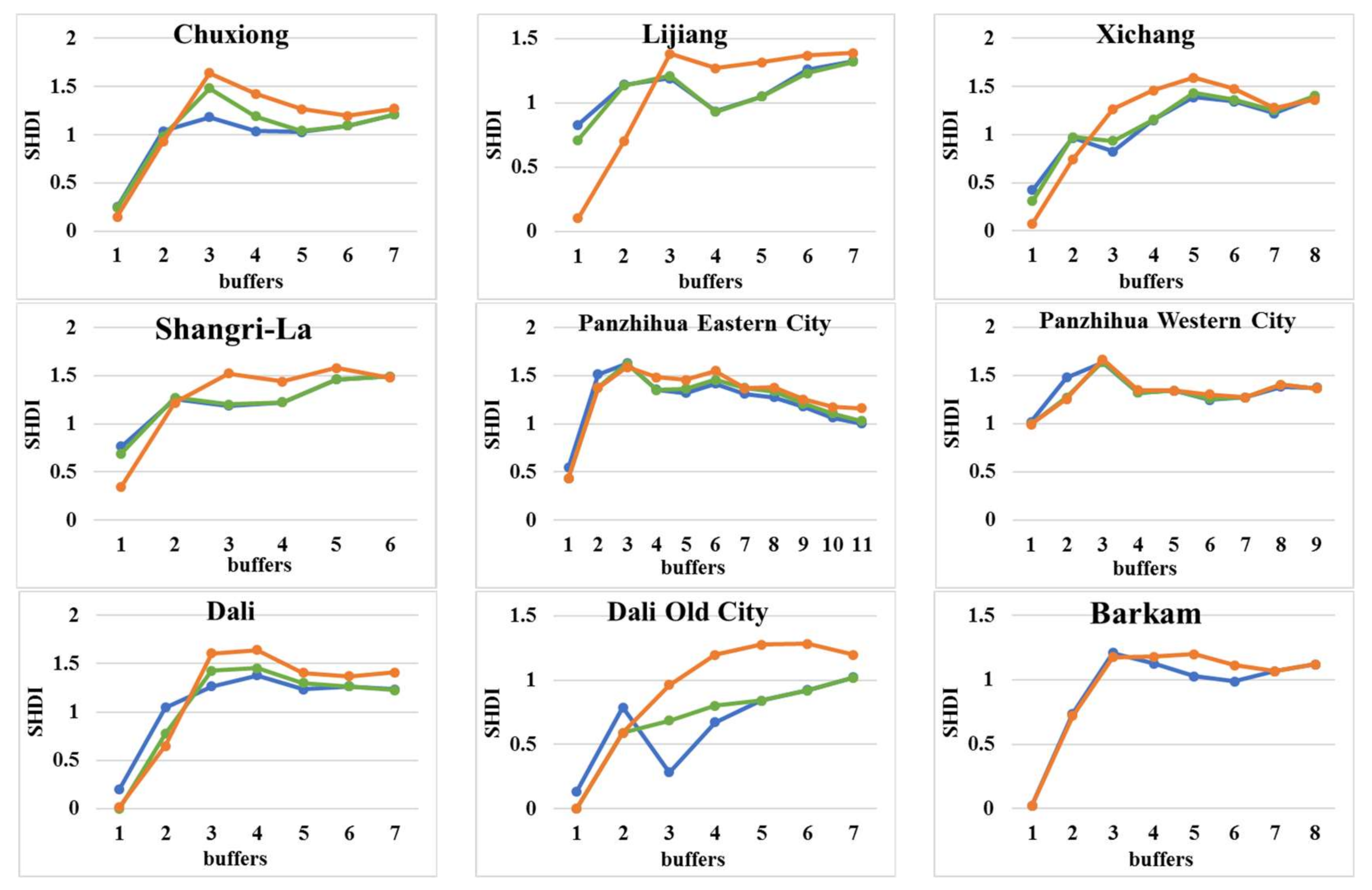

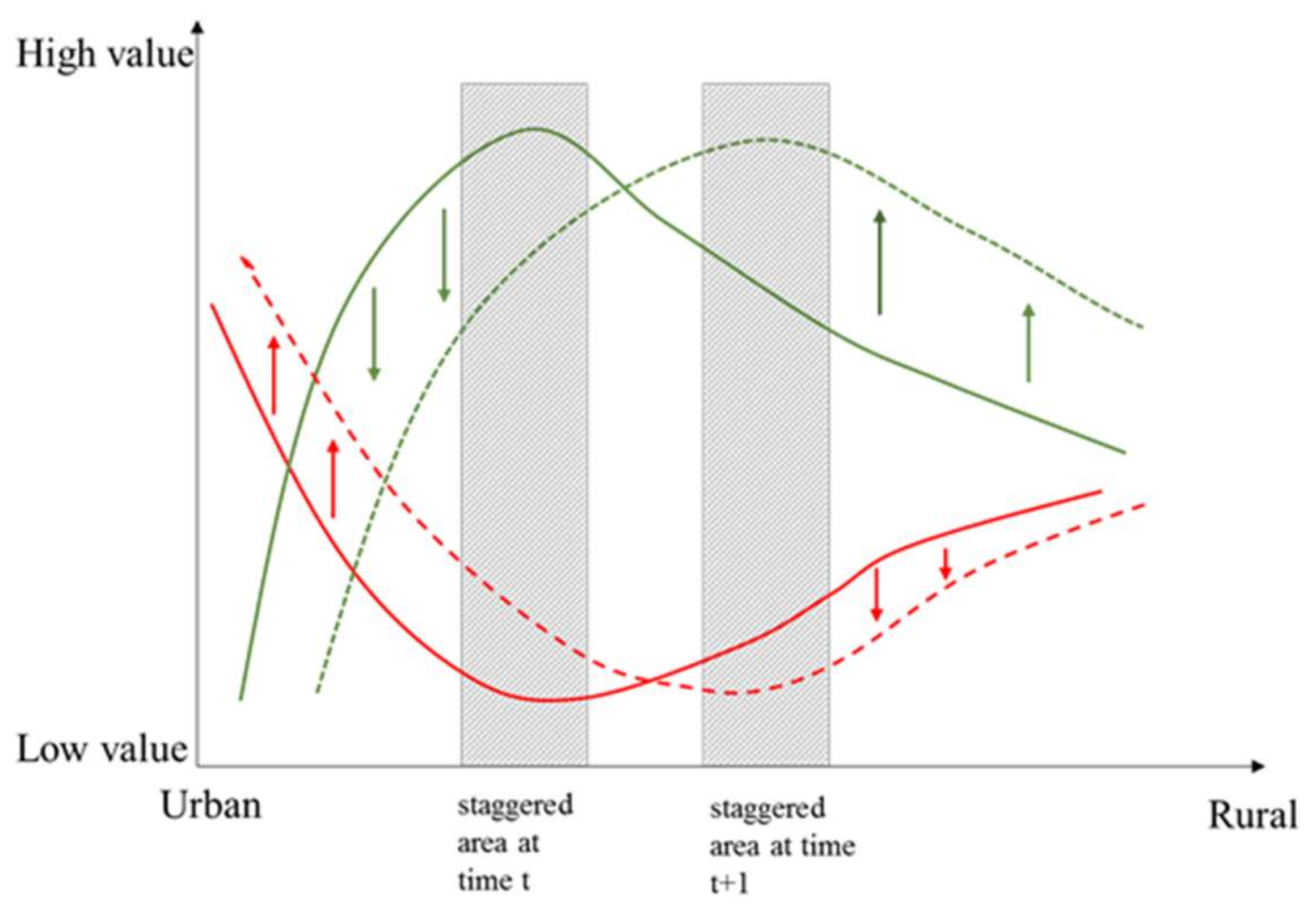

| City | The Smallest Circle That Contains All of the Urban Land in 2010 | The Number of the Outermost Buffer | Interval Width |
|---|---|---|---|
| Chuxiong | 5 | 7 | 1 km |
| Lijiang | 5 | 7 | 1 km |
| Xichang | 8 | 8 | 1 km |
| Shangri-La | 4 | 6 | 1 km |
| Panzhihua Eastern City | 11 | 11 | 1 km |
| Panzhihua Western City | 9 | 9 | 1 km |
| Dali | 6 | 7 | 1 km |
| Dali Old City | 6 | 7 | 0.5 km |
| Barkam | 6 | 8 | 0.1 km |
| Kangding | 14 | 15 | 0.1 km |
| Landscape Metrics | Category | Range | Description |
|---|---|---|---|
| LPI | Area | Range: 0 < LPI ≤ 100 | The percentage of total landscape area comprised by the largest patch. It is a simple measure of dominance. The more noticeable the dominance, the higher the LPI value. |
| AWMPFD | Shape | 1 ≤ AWMPFD ≤ 2 | Describes the irregularities or complexity of patch shapes. Values closer to 1 indicate simple shapes. |
| CONTAG | Aggregation | 0 < CONTAG ≤ 100 | The value approaches 0 when the patch types are as disaggregated or interspersed as possible. |
| SHDI | Diversity | SHDI ≥ 0 | Reflect the diversity of the landscape. The SHDI value increases as the number of different patch types increases. |
| PLAND | Area | 0 < PLAND ≤ 100 | The percentage of the total landscape occupied by each patch type. When the value approaches 100, the area of the corresponding patch type increases in the landscape. |
© 2018 by the authors. Licensee MDPI, Basel, Switzerland. This article is an open access article distributed under the terms and conditions of the Creative Commons Attribution (CC BY) license (http://creativecommons.org/licenses/by/4.0/).
Share and Cite
Dai, E.; Wang, Y.; Ma, L.; Yin, L.; Wu, Z. ‘Urban-Rural’ Gradient Analysis of Landscape Changes around Cities in Mountainous Regions: A Case Study of the Hengduan Mountain Region in Southwest China. Sustainability 2018, 10, 1019. https://doi.org/10.3390/su10041019
Dai E, Wang Y, Ma L, Yin L, Wu Z. ‘Urban-Rural’ Gradient Analysis of Landscape Changes around Cities in Mountainous Regions: A Case Study of the Hengduan Mountain Region in Southwest China. Sustainability. 2018; 10(4):1019. https://doi.org/10.3390/su10041019
Chicago/Turabian StyleDai, Erfu, Yahui Wang, Liang Ma, Le Yin, and Zhuo Wu. 2018. "‘Urban-Rural’ Gradient Analysis of Landscape Changes around Cities in Mountainous Regions: A Case Study of the Hengduan Mountain Region in Southwest China" Sustainability 10, no. 4: 1019. https://doi.org/10.3390/su10041019






